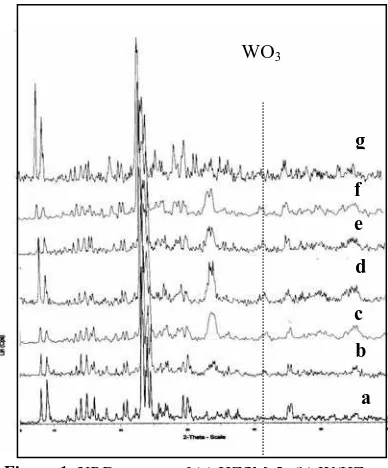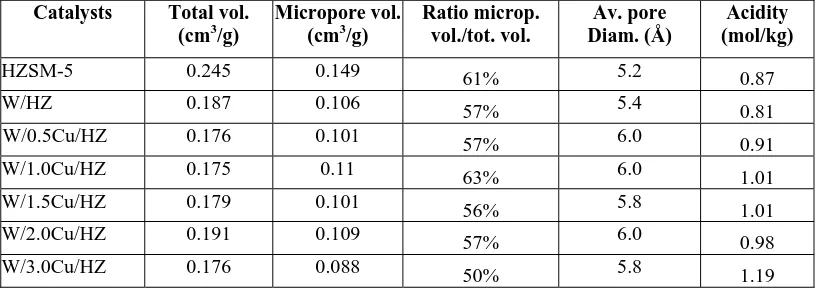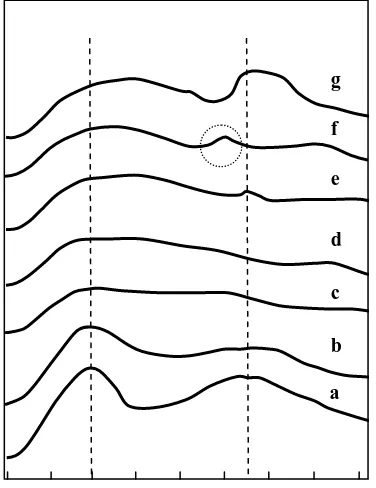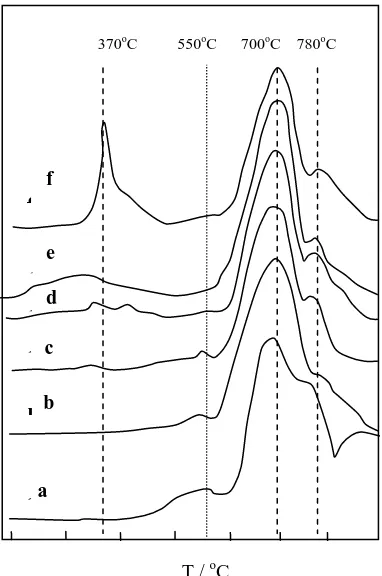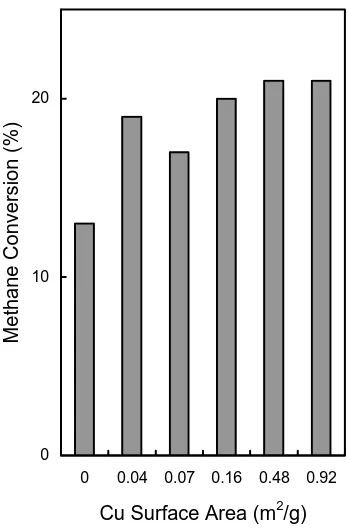CHARACTERIZATION AND PERFORMANCE OF
W-ZSM-5 AND W LOADED Cu/ZSM-5 CATALYSTS
Didi Dwi Anggoro
Department of Chemical Engineering, Faculty of Engineering, University of Diponegoro Jl. Prof Sudharto SH, Tembalang, Semarang 50239, Email:
[email protected]
Nor Aishah Saidina Amin
Faculty of Chemical and Natural Resources, University of Technology Malaysia Skudai, Johor Bahru, Malaysia
Abstract
The modified HZSM-5 by loading with Tungsten (W) enhanced its heat resistant performance, and the high reaction temperature (800oC) did not lead to the loss of W component by sublimation. The loading of HZSM-5 with Tungsten and Copper (Cu) resulted in an increment in the methane conversion, CO2 and C5+ selectivities. In contrast, CO, C2-3, and H2O selectivities were reduced. The process to convert methane to liquid hydrocarbons (C5+) was dependent on the metal surface area and the acidity of the zeolite. The high methane conversion and C5+ selectivity, and low H2O selectivity are obtained by using W/3.0Cu/HZSM-5.
Key words: Characterization, Modified HZSM-5, Tungsten, Copper, Methane
Abstrak
Modifikasi HZSM-5 dengan penambahan logam Tungsten (W) meningkatkan daya tahan panas and pada reaksi suhu tinggi (800oC) tidak menyebabkan hilangnya logam W dikarenakan proses sublimasi. Penambahan logam Tungsten dan Copper (Cu) menyebabkan meningkatnya konversi metana, selektifitas CO2 dan C5+. Sebaliknya, selektifitas CO, C2-3, and H2O menurun. Proses mengkonversi metana menjadi hidrokarbon cair (C5+) ditentukan oleh luas permukaan logam dan sifat keasaman dari zeolit. Dengan menggunakan W/3.0Cu/HZSM-5 katalis menghasilkan konversi metana dan selektifitas C5+ tinggi dan selektifitas H2O rendah.
Kata Kunci: Karakterisasi, Modifikasi HZSM-5, Tungsten, Copper, Metana
1. Introduction
Ernst and Weitkamp (1989) reported in a paper on the conversion of methane over zeolite-based catalysts that the presence of strong acid sites in the zeolite catalyst is detrimental for the selective oxidation of methane to higher hydrocarbons; otherwise oxidized products, COx (CO, CO2) predominate. When the acidity is reduced by exchanging the zeolite with alkali metal cations, the selectivity to higher hydrocarbons is slightly enhanced. Han et al. (1994 a,b) demonstrated the production of higher hydrocarbons from methane oxidation using a ZSM-5 zeolite catalyst containing metal oxides. The metal oxides with sufficiently high
dehydrogention and low olefin oxidation activities reduces the acidity of ZSM-5. As a result, the metal containing ZSM-5 can produce higher hydrocarbons in methane oxidation.
Bandung, 6-7 Oktober 2004
ISSN-0854-7769 Perancangan dan Pengembangan Katalis first two hours of reaction, and the
corresponding selectivity to benzene, naphthalene, ethylene and coke was 48-56%, 18%, 5%, and 22%, respectively. Ding et al. (2001) reported the non-oxidative methane reaction over W/HZSM-5 that produced C2-C12 hydrocarbons. The C2-C12 selectivity was 70-80%. However, the methane conversion was small between 2% and 3%. On the basis of the chemical similarities between MoO3 and WO3, it seems reasonable to expect a parallelism in their catalytic properties. Mo species was the most active component for methane non-oxidative aromatization so far, but its activity and stability needed to be improved. Recently, we found that the introduction of Cu(II) ions by an ion-exchange method can remarkably increase the activity of Mo/HZSM-5 for methane aromatization and can improve its stability to some extent.
Cu loaded ZSM-5 catalyst via acidic ion exchange method has been identified to be the catalyst for conversion of methane to liquid fuels (Anggoro and Amin, 2001a, b). However, the infrared study of metal loaded ZSM-5 catalyst indicated that the catalysts were not resistant to high temperature. Previous studies have indicated that metal loaded ZSM-5 did not exhibit vibration band at 3610 cm-1 and 3660 cm-1, except for ZSM-5 which showed a weak vibration band at 3666 cm-1. The result suggested that the framework and non-framework aluminum were either extracted to acidic solution or became silanol defect form when calcined at 800oC and made the catalysts inactive.
In this paper ZSM-5 was modified with tungsten and copper and the catalyst performance was tested for the oxidation of methane to liquid hydrocarbons. The catalysts were characterized by XRD, TPR, TPD, and N2 Adsorption measurements. This paper investigated the resistivity of tungsten modified HZSM-5 to high temperature and its catalytic activity for the conversion of methane.
2. Experiment
ZSM-5 zeolite with a SiO2/Al2O3 mole ratio of 30 was supplied by Zeolyst International Co. Ltd. Netherlands. The surface area of the zeolite was 400 m2/g. The W (3% weight)-HZSM-5 catalyst was prepared by impregnating a certain amount of the HZSM-5 zeolite carrier with ammonium tungstate hydrate solution (Xiong et al. 2001). The ammonium tungstate hydrate solution was prepared by dissolving (NH4)2WO4 in deionized water. A small amount of H2SO4 was added to regulate the pH value of the
solution to 2-3. The sample (10 ml of solution per gram zeolite) was dried in an oven at 120oC for two hours and then calcined at 500oC for four hours.
The W loaded Cu/HZSM-5 was prepared by first impregnating a certain amount of the HZSM-5 zeolite carrier with a calculated amount of copper nitrate in aqueous solutions, followed by drying at 120oC for two hours and calcining at 400oC for four hours, and subsequently impregnating with a calculated amount of H2SO4 acidified (NH4)2WO4 aqueous solution (pH= 2-3). Finally, the sample was dried at 120oC for two hours and calcined at 500oC in air for five hours.
XRD, H2-TPR, NH3-TPD, N2 adsorption, and FT-IR carried out the characterization of catalysts. The performance of the catalysts was tested for methane conversion to liquid hydrocarbons (LHC) via a single step reaction in a fixed-bed micro reactor (Anggoro and Amin, 2001a, b). Methane with 99.9% purity reacted at atmospheric pressure, various temperature and oxygen concentration. An on-line Gas Chromatography with TCD and Porapak-N column was utilized to analyze the gas. The liquid product was analyzed using GC FID and HP-1 column.
3. Results and Discussions
X-ray diffraction (XRD) and nitrogen adsorption (NA) were employed to determine the morphology of the catalysts. The XRD diffractograms of HZSM-5, W/HZSM-5 and W loaded Cu/HZSM-5 catalysts with different Cu loadings calcined at 550oC are shown in Fig 1.
Table 1. Crystallinity and surface area of the catalysts
Catalysts Crystallinity BET surface area m2/g
Micropore area m2/g
HZSM-5 100% 403 373
W/HZ 100% 280 257
W/0.5Cu/HZ 94% 266 243
W/1.0Cu/HZ 89% 286 261
W/1.5Cu/HZ 101% 267 244
W/2.0Cu/HZ 88% 285 260
W/3.0Cu/HZ 69% 236 213
Table 2. Total volume, pore distribution and acidity of the catalysts
Catalysts Total vol. (cm3/g)
Micropore vol. (cm3/g)
Ratio microp. vol./tot. vol.
Av. pore Diam. (Å)
Acidity (mol/kg)
HZSM-5 0.245 0.149 61% 5.2 0.87
W/HZ 0.187 0.106 57% 5.4 0.81
W/0.5Cu/HZ 0.176 0.101 57% 6.0 0.91
W/1.0Cu/HZ 0.175 0.11 63% 6.0 1.01
W/1.5Cu/HZ 0.179 0.101 56% 5.8 1.01
W/2.0Cu/HZ 0.191 0.109 57% 6.0 0.98
W/3.0Cu/HZ 0.176 0.088 50% 5.8 1.19
The peaks at 2θ = 41 indicated tungsten oxides (Logie et al. 2000) whilst copper oxides were indicated at 2θ= 34 (Li et al. 1999). The intensities of these peaks increased with increasing copper loading.
The crystallinity values calculated from the XRD diffractograms and the areas of the samples from NA analysis are tabulated in Table 1. The crystallinities of W/1.0Cu/HZM-5, W/2.0Cu/HZSM-5 and W/3.0Cu/HZSM-5 were 89%, 88%, 69%, respectively. These values were lower compared to the values of other samples. All the metal and bi-metal ZSM-5 zeolite catalysts have surface and micropore areas smaller than the parent zeolite.
The reduction in the surface area of the metal-loaded HZSM-5 indicated a strong interaction between the surface of the zeolite and the copper and tungsten species, which enabled a good dispersion of metals on the surface (de Lucas et al. 2001). Among the samples, the BET surface area and the micropore area of W/3.0Cu/HZSM-5 were the lowest at 236 m2/g and 213 m2/g, respectively.
The results in Table 2 pertain to the total volume, micropore volume, average pore diameter and acidity of the catalysts. Tungsten and copper species easily entered or partially blocked the channels of the ZSM-5 zeolite pores and thus reduced the volume of the
catalysts. The average pore diameters of the metal-loaded HZSM-5 zeolites were larger than the parent zeolite as revealed by the results in Table 2. The average pore diameter of W/3.0Cu/HZSM-5 was the largest, and as indicated in Table 2, the percentage of micropore volume in the catalyst surface was reduced to 50%.
The ammonia-TPD spectra of the catalyst provided useful information about the intensity and the concentration of the acid sites on the catalysts surface as tabulated in Table 2. The concentrations of the surface acid sites (acidity) of the metal-loaded HZSM-5 were higher than the ZSM-5 zeolite. This could probably be attributed to the average pore diameters of the metal-loaded HZSM-5 which were larger than the pore diameters of HZSM-5 zeolite itself, as shown in Table 2.
Bandung, 6-7 Oktober 2004
ISSN-0854-7769 Perancangan dan Pengembangan Katalis The addition of 0.5 % Cu to HZSM-5
led to the reduced intensity of the high temperature (∼ 430oC) peak and a small downshift of its position as revealed in Figure 2. When the amount of Cu loading increased to 1.0%, the high temperature peak disappeared, indicating that most of the surface Brönsted acid sites vanished.
Figure 2. Ammonia-TPD spectra of (a) HZSM-5; (b) W/HZ; (c) W/0.5Cu/HZ; (d) W/1.0Cu/HZ; (e) W/1.5Cu/HZ; (f) W/2.0Cu/HZ; (g) W/3.0Cu/HZ
However, as the copper loading was further increased at 1.5% and 3.0%, the ammonia-TPD peaks appeared again at ∼ 430oC. One interesting feature of Figure 6.6 is the ammonia-TPD spectra of W/2.0Cu/HZSM-5 which indicated a peak at 400oC (Figure 2 (f)). This small peak may be attributed to the emergence of medium strength Brönsted acid sites. This is similar with the results found by previous researchers (Xiong et al. 2001), where the incorporation of Mg2+ and Zn2+ into the W/HZSM-5 host catalyst resulted in the elimination of strong surface Brönsted acid sites and the generation of new medium-strength acid sites.
The migration of W and Cu species was indirectly studied by infrared (IR) spectroscopy. W/HZSM-5 and W/Cu/HZSM-5 samples showed that in the OH stretching vibration three IR bands at ≈ 3610 cm-1, due to bridge Si-OH (Al) acidic groups, at ≈ 3660 cm -1
due to non-framework Al sites, or octahedral, and at ≈ 3740 cm-1 were attributed to terminal Si-OH non-acidic groups (Amin and Anggoro, 2002). The vibrations (OH) region of the IR
spectra of W/HZSM-5 and W/3.0Cu/HZSM-5 zeolite catalysts are shown in Figure 3, where all the fresh samples have bands at ≈3,610 cm-1,
≈3,660 cm-1, and ≈3,740 cm-1. The spectra indicated that all the samples have aluminum framework, silanol, and aluminum non-framework groups. In addition, the IR spectra demonstrated that the intensity of the band at ≈ 3,610 cm-1 of fresh W/HZSM-5 was stronger than fresh W/3.0Cu/HZSM-5. This is probably due to W or W and Cu species that have migrated in the zeolite framework and occupied the H+ position. It resulted in a large decrement of the 3610 cm-1 IR band intensity, as shown in Figure 3 (c).
It is clear that the roles of W on
W/HZSM-5 and W and Cu on W/Cu/HZSM-5 were to reduce the amount of Brönsted acid sites. The amount of Brönsted acid sites (NBAC) was calculated by bridging OH groups (at 3,609 cm-1 band) according to Amin and Anggoro, (2002) and Wichterlova et al. (1998). The NBAC for the HZSM-5, W/HZSM-5 and W/3.0Cu/HZSM-5 were 2.9 µmole/g, 0.5
µmole/g and 0.3 µmole/g respectively.
Further reaction with methane and oxygen at 800oC for five hours resulted in the disappearance of the band at ≈ 3,610 cm-1 for both W/HZSM-5 and W/Cu/HZSM-5 samples a
b c d e f g
a
d
c
b
1/cm 3740 3610
3660
Figure 3. IR spectra in the OH region of ( __ ) fresh (a) W/HZSM-5 and (c) W/3.0Cu/HZSM-5, (---) used (b) W/HZSM-5 and (d) W/3.0Cu/HZSM-5 for reaction at 800oC
a b c
(Figures 3.(b) and 3 (d)). This is probably due to the extraction of aluminum in the zeolitic framework into the non-framework or due to the deposition of carbonaceous residues. The deposition of the coke led to catalyst deactivation after five hours of reaction.
The TPR profiles of W/HZSM-5 and W loaded Cu/HZSM-5 catalysts are depicted in Figure 4. As observed, all the curves contain several peaks in the temperature range of 200-900oC. The TPR patterns of all catalysts exhibited two peaks with the maximum at 700oC and 780oC. These peaks may be ascribed to the two subsequent steps of single-electron reduction of the W6+ species derived from the (WO4)2- precursor with tetrahedral coordination, W6+ + e-Æ W5+ and W5+ + e-Æ W4+ (Shu et al. 1997). The reducibility of this type of catalyst decreased as the strength of the interaction between the metal oxide species and the surface of the support increased.
Figure 4. Hydrogen-TPR spectra of (a) W/HZSM-5; (b) W/0.5Cu/HZ; (c) W/1.0Cu/HZ; (d) W/1.5Cu/ HZ; (e) W/2.0Cu/HZ; (f) W/3.0Cu/ HZ
The existence of a single reduction peak at 550oC for W/HZSM-5, W/0.5Cu/HZSM-5 and W/1.0Cu/HZSM-5 samples may be due to the single electron reduction of the W6+ species derived from the (WO6)n- precursor with octahedral coordination, W6+ + e- Æ W5+ (Xiong et al. 2001). This peak (at 550oC)
disappeared if the amount of Cu loading on the HZSM-5 was more than 1.0 wt%. The observed hydrogen-TPR peak at 370oC could be due to the reduction of Cun+ species and the intensity of the peak became stronger as the copper loading increased.
In Table 3 the quantitative results of the TPR is summarized. The tungsten content for all catalysts was constant. The copper content and % of copper dispersed for W/Cu/HZSM-5 catalysts increased with increasing copper concentration. The mean tungsten and copper particle size were estimated to be down to 2 nm (20 Å). Such small particles, particularly tungsten particles, should be localized to inside the zeolite mesopores (Hoang et al. 1994).
The results in Table 3 indicated the dispersion of Cu on W/1.0Cu/HZSM-5 was the smallest (about 22%) compared to the other samples, owing to the largest mean particle diameter of Cu (1.721 nm) on W/1.0Cu/HZSM-5. The small percentage of Cu being dispersed on W/1.0/HZSM-5 catalyst led to only a small amount of Cu ions being exchanged with H+. As a consequence, the acidity of W/1.0/HZSM-5 was high (1.01 mol/kg), although its pore size was small (24.4 Å). It is clear that the role of Cu on W/Cu/HZSM-5 was not only to reduce W6+ species derived from the (WO6)n- precursor with octahedral coordination, but also to have an effect on the acidity of the ZSM-5 zeolite as revealed by the ammonia-TPD result.
The TPR profiles of W loaded 3.0Cu/HZSM-5 catalysts before and after reaction are depicted in Figure 5. The spectra demonstrated the existence of a single reduction peak of Cu oxide at 370oC.
Figure 5. Hydrogen-TPR spectra of W/3.0Cu/HZSM-5 catalyst before and after reaction at 800oC
Fresh Used
200 400 600 800 T (oC)
a
b
c
d
e
f
T / oC
370oC 550oC 700oC 780oC
Bandung, 6-7 Oktober 2004
ISSN-0854-7769 Perancangan dan Pengembangan Katalis Table 3. Metal state in the reduced catalysts
Catalyst Metal content
(µmol/g)
Metal surface area (m2/g)
Dispersion of metal (%)
Mean particle diameter (nm)
W Cu W Cu W Cu W Cu
W/HZ 163 - 2.66 - 55 - 0.0518 -
W/0.5Cu/HZ 163 79 6.02 0.04 100 24 0.0287 1.559 W/1.0Cu/HZ 163 157 4.00 0.07 68 22 0.0419 1.721 W/1.5Cu/HZ 163 236 3.11 0.16 65 40 0.0444 0.930 W/2.0Cu/HZ 163 315 4.18 0.48 76 79 0.0379 0.475 W/3.0Cu/HZ 163 472 4.77 0.92 86 100 0.0332 0.373
However, after reaction at 800oC the peak disappeared, probably due to the reduction of Cun+. Nevertheless, the peak of Wn+ did not change before and after the reaction. The TPR profile for tungsten revealed that the addition of tungsten has increased the thermal stability of the catalyst, as the W component was not lost by sublimation after reaction at 800oC.
The methane conversion increased due to the increasing copper content and copper surface area, as shown in Figure 7. This result demonstrated that the methane conversion was related to the copper surface area.
0 10 20
0 0.04 0.07 0.16 0.48 0.92
Cu Surface Area (m2/g)
Methane Conversion (%)
Figure 7. Effect of Cu BET surface area on methane conversion
The products of the reaction between methane and oxygen over HZSM-5, W/HZSM-5, and W/Cu/HZSM-5 with different concentrations of copper were C2H2, C2H4,
C2H6, C3H6, CO, CO2, H2O, and liquid hydrocarbons. Figure 8 summarizes the product selectivities of all the catalysts. The result in Figure 8 shows that over HZSM-5 and metal loaded HZSM-5, the selectivity of carbon monoxide was higher than carbon dioxide. This indicates that the partial oxidation of methane occurred with carbon monoxide and hydrogen as the products. However, hydrogen possibly reacted with carbon dioxide to form water in the Reversed Water Gas Shift (RWGS) reaction.
From the ammonia-TPD (Figure 2) spectra the strength of Brönsted acid sites of W/3.0Cu/ZSM-5 was the strongest among others. These results suggest that production of gasoline form from methane depend on the number and the strength of Brönsted acid sites as well as the total acidity of the catalyst surface. The optimization this reaction was studied using
Statsoft Statistica (Amin and Anggoro, 2003).
4. Conclusions
The loading of HZSM-5 with tungsten and copper decreased the crystallinity, surface area, and also the total volume of the catalysts. However, the average pore diameter and the acidity of the zeolites increased as a result of the modification with the metals. Such metal particles were smaller than the mesopore size, and the metal particles should be localized to the inner side of the zeolite mesopores. TPR analysis indicated that modified HZSM-5 by loading with Tungsten enhanced its heat resistant performance, and the high reaction temperature (800oC) did not lead to the loss of W component by sublimation.
0% 25% 50% 75% 100% HZSM-5
W/HZ W/0.5Cu W/1.0Cu W/1.5Cu W/2.0Cu W/3.0Cu
Product Selectivities
Figure 8. The distribution of product selectivities over different catalysts.
( ) CO ( ) CO2 ( ) C2-3 hydrocarbons ( ) C5+ liquid hydrocarbons ( ) water
Refferences
[1] Amin, N. A. S. and Anggoro, D. D. (2003). Optimization od direct conversion of methane to liquid fuels over Cu Loade W/ZSM-5 catalyst.
FUEL. 83(4-5): 487-494.
[2] Amin, N. A. S. and Anggoro, D. D. (2002). Dealuminated ZSM-5 Zeolite Catalyst for Ethylene Oligomerization to Liquid Fuels. Journal of Natural Gas
Chemistry. 11(1-2): 79-86.
[3] Anggoro, D. D. and Amin, N. A. S. (2001a). Metal loaded dealuminated HZSM-5 for methane conversion to liquid hydrocarbons. Proceeding of the
Bangkok International Conference on Heterogeneous catalysis. January 5-7.
Bangkok, Thailand.
[4] Anggoro, D. D. and Amin, N. A. S. (2001b). The activity of HZSM-5 zeolite catalyst loaded with metal for single step
conversion of methane to gasoline.
Proceeding of the 6th World Congress of Chemical Engineering. October 20-24.
Melbourne, Australia.
[5] de Lucas, A., Valverde, J. L., Canizares, P. and Rodriguez, L. (1998). Partial oxidation of methane to formaldehyde over W/HZSM-5 catalysts. Applied
Catalysis A. 172: 165-176.
[6] de Lucas, A., Valverde, J. L., Canizares, P. and Rodriguez, L. (1999). Partial oxidation of methane to formaldehyde over W/SiO2 catalysts. Applied Catalysis
A. 184: 143-152.
[7] de Lucas, A., Valverde, J. L., Rodriguez, L., Sanchez, P. and Garcia, M. T. (2001). Modified W/HZSM-5 catalysts: structure and catalytic properties. Journal
Molecular Catalyst A. 171: 195-203.
[8] Ding, W., Meitzner, G.D., Marler, D.O. and Iglesia, E. (2001). Synthesis,
Structural Characterization, and Catalytic Properties of Tungsten-Exchanged H-ZSM5. Journal Physical Chemistry. 105: 3928-3936.
[9] Ernst, S. and Weitkamp, J. (1989). Oxida- tive coupling of methane using zeolite-based catalysts. In Imarisio, G., Frias, M. and Bemtgen, J. M. Hydrocarbons Source
of Energy. London: Graham & Trotman.
461-469.
[10] Han, S., Martenak, D. J., Palermo, R. E., Pearson, J. A. and Walsh, D. E. (1994a). Direct partial oxidation of methane over ZSM-5 catalyst: metals effects on higher hydrocarbon formation. Journal of
Catalysis. 148: 134-137.
[11] Han, S., Kaufman, E. A., Martenak, D. J., Palermo, R. E., Pearson, J. A. and Walsh, D. E. (1994b). Direct Partial Oxidation of Methane over ZSM-5 catalyst: Zn-ZSM-5 catalyst studies. Catalysis Letters. 29: 27-32.
[12] Hoang, D. L., Berndt, H., Miessner, H., Schreier, E., Volter, J. and Lieske, H. (1994). Nickel modified H-ZSM-5 catalysts. Applied Catalysis A: General. 114: 295-311.
[13] Li, S., Zhang, C., Kan, O., Wang, D., Wu, T. and Lin, L. (1999). The function of Cu(II) ions in the Mo/CuH-ZSM-5 catalyst for methane conversion under non-oxidative condition. Applied
Catalysis A: Genera. 187: 199-206.
[14] Logie, V., Wehrer, P., Katrib, A and Maire, G. (2000). Catalytic Activity of
Bandung, 6-7 Oktober 2004
ISSN-0854-7769 Perancangan dan Pengembangan Katalis and Hexenes. Journal of Catalysis. 189:
438-448.
[15] Shu, Y., Xu, Y., Wong, S.T., Wang, L. and Guo, X (1997). Promotional Effect
of Ru on the Dehydrogenation and Aromatization of Methane in the Absence of Oxygen over Mo/HZSM-5 Catalysts. Journal of Catalysis. 170: 11-19.
[16] Wichterlova, B., Tvaruzkova, Z., Soba- lik, Z. and Sarv, P. (1998).
Determination and properties of acid sites in H-ferrierite A comparison of ferrierite and MFI structures.
Microporous and Mesoporous Materials. 24: 223-233.
[17] Woolery, G. L., Kuehl, G. H., Timken, H. C., Chester, A. W. and Vartuli, J. C. (1997). On the nature of framework Bronsted and Lewis acid sites in ZSM-5.
Zeolites. 19: 288-296.
[18] Xiong, Z. T., Chen, L. L., Zhang, H. B., Zeng, J. L. and Lin, G.D. (2001 a). Study of W/HZSM-5 based catalysts for dehydroaromatization of CH4 in absence of O2. I. Performance of catalysts.
Catalysis Letters, 74: 227-232.
[19] Xiong, Z.T., Zhang, H.B., Lin, G.D and Zeng, J.L (2001 b). Study of W/HZSM-5 based catalysts for dehydroaromatization of CH4 in absence of O2. II. Action of promoters Zn and Li.
